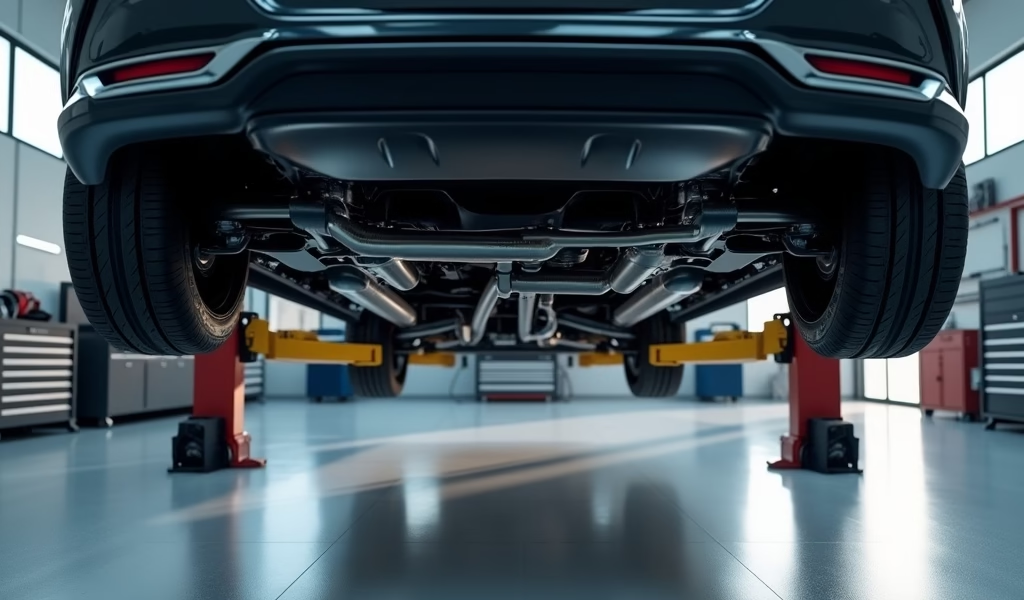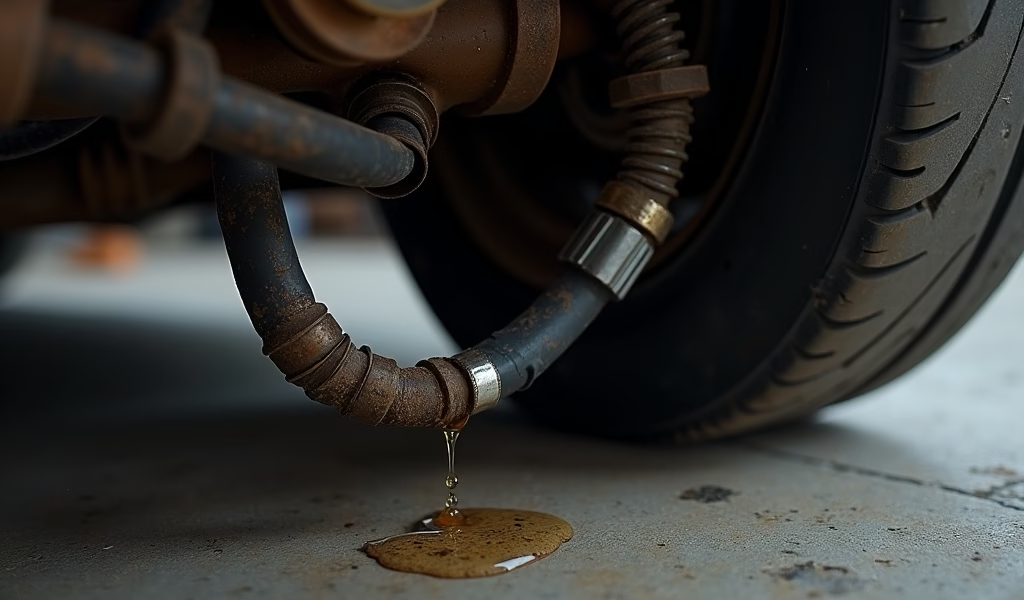Overview
This expert guide outlines seven critical brake line routing specifications for vehicle safety, including maintaining proper clearance from moving parts, choosing appropriate materials, secure mounting techniques, avoiding common routing mistakes, accommodating suspension movement, creating proper line connections, and thorough testing protocols. Following these specifications helps prevent brake failure and ensures reliable stopping power, with the author emphasizing that proper brake line routing is not merely a suggestion but a vital safety discipline based on decades of professional experience.
Table of Contents
- Introduction
- Clearance Matters: Keeping Safe Distances
- Choosing the Right Materials for Your Vehicle
- Proper Mounting: Securing Without Stressing
- Avoid These Common Routing Mistakes
- Account for Suspension Movement
- Master Line Junctions and Connections
- Testing and Inspection: The Final Crucial Step
- Conclusion
- Frequently Asked Questions
Introduction
Your brake lines are the unsung heroes of vehicle safety. Think of them as the lifelines carrying that critical brake fluid from your pedal to your wheels. When you hit the brakes, you’re literally betting your life on those small metal tubes doing their job correctly.
I’ve been working on brake systems for over 20 years, and I can tell you – proper brake line routing isn’t just some suggestion in a dusty manual. It’s absolutely vital to your vehicle’s safety and braking performance. One careless routing mistake can mean the difference between stopping on a dime or having a very bad day.
In my shop, we’ve seen everything from factory-perfect setups to DIY nightmares that make us lose sleep. That’s why I’ve put together these seven expert tips on brake line routing specifications that’ll help keep you and your passengers safe on the road.
Clearance Matters: Keeping Safe Distances
Let me paint you a picture: your brake lines are like nervous cats – they need their space from moving parts. Inadequate clearance is the number one killer of perfectly good brake lines, and I’ve seen it happen more times than I care to count.
The golden rule? Maintain a minimum of 3/4 inch clearance between any brake line and moving components. This includes suspension parts, steering mechanisms, exhaust components, and drivetrain parts that shift during operation.
Here’s what to watch for:
- Suspension arms at full compression and extension
- Steering components when turned lock-to-lock
- Engine and transmission movement (they dance around more than you think!)
- Exhaust pipes that heat up and expand
Just last month, I had a customer tow in his truck after a complete brake failure. The culprit? A brake line that had been routed too close to the suspension. Every bump was like taking sandpaper to that line until it finally wore through. An inch of clearance would have prevented a $600 repair and a seriously scary moment on the highway.
When checking clearance, don’t just eyeball it with the vehicle sitting static in your garage. Get under there and have a helper move the suspension and steering through their full range of motion while you watch for close calls. Your future self will thank you.

Choosing the Right Materials for Your Vehicle
Not all brake lines are created equal, and choosing the right material is like picking the right tool for the job – it makes all the difference. Your choice should depend on your vehicle’s use, environment, and how long you plan to keep it on the road.
Here’s the breakdown of your options:
Steel Lines
Standard steel brake lines are what most vehicles come with from the factory. They’re cost-effective and do the job well in most conditions. Think of them as your reliable workhorse – not fancy, but they get the job done with proper maintenance.
The downside? They’re vulnerable to rust, especially if you live where roads get salted in winter. I’ve seen 5-year-old steel lines in Michigan that look like they’ve spent 50 years underwater.
Stainless Steel Lines
The premium option, and my personal recommendation for any vehicle you plan to keep long-term. Stainless steel lines cost more upfront but can outlast multiple sets of standard steel lines. They resist corrosion beautifully and handle higher brake system pressure with ease.
For performance vehicles or anything subjected to harsh conditions, stainless is worth every penny. According to research from the Society of Automotive Engineers, stainless steel brake lines can maintain integrity up to five times longer than conventional steel in corrosive environments.
Flexible Lines
These are typically used where you need movement, like from the frame to the calipers. The critical thing here is to use only DOT-approved brake hose – never substitute with fuel line or general-purpose hose. I’ve seen the aftermath of that mistake, and it’s not pretty.
For classic car restorations, I’m a big fan of nickel-copper alloy (sometimes called CuNi) lines. They give you excellent corrosion resistance with easier bending characteristics than stainless. They’re pricey but perfect for that show car you’re babying.
Proper Mounting: Securing Without Stressing
Think of brake line mounting like holding a baby bird – secure enough that it doesn’t fall, but not so tight you crush it. Proper mounting prevents vibration damage while allowing for the natural expansion and contraction that happens as your brakes heat up and cool down.
Here are my mounting must-follows:
- Secure lines every 12-18 inches along straight runs
- Use rubber-lined P-clips or specialized brake line clamps
- Never mount directly on a bend – leave at least an inch of straight line on either side
- Use grommets when passing through metal panels or frame holes
I remember working on a customer’s classic Mustang where the previous owner had used zip ties to secure the brake lines. Over time, the plastic degraded, the lines came loose, and started vibrating against the frame. By the time he brought it in, the lines looked like they’d been attacked with a file. Don’t be that guy.
For dual lines running parallel, use proper line separators instead of bundling them together. This prevents metal-on-metal contact that can wear through over time and makes individual line replacement much easier down the road.
One pro tip from my years in the shop: leave a little slack in your lines, especially near flex points. Brake lines expand when they heat up, and if they’re mounted too tight when cold, they can develop stress cracks over time as they try to expand.
Avoid These Common Routing Mistakes
After seeing thousands of brake jobs come through my shop, I’ve developed a sixth sense for spotting routing no-nos. These are the mistakes that separate the professionals from the amateurs, and they can make or break your system’s reliability.
Let’s tackle the big ones:
Heat Exposure
Brake lines and heat are sworn enemies. Never route lines within 2 inches of exhaust components. The heat doesn’t just damage the line – it can boil your brake fluid, leading to vapor lock and complete brake failure. I’ve seen it happen on a customer’s truck after someone routed a line over the exhaust manifold during a rushed repair.
Sharp Bends
Your brake lines aren’t contortionists. Any bend should have a radius at least three times the diameter of the line itself. Tighter bends restrict flow and create weak points. Use a proper tubing bender – those $15 tools will save you hundreds in repairs.
Exposed Positioning
Whenever possible, route lines along frame rails or inside protected areas. A brake line hanging below your vehicle is just begging to catch road debris or scrape on speed bumps. I had a customer who lost his brakes after a plastic shopping bag wrapped around his exposed line and yanked it clean off the fitting.
Unprotected Crossings
When lines must cross potential wear points or movable parts, use protective sleeves or grommets. That extra layer of protection is cheap insurance against catastrophic failure.
One commonly overlooked mistake: failing to secure lines away from the load sensing valve adjustment mechanisms. I’ve seen several cases where lines gradually wore through from slight contact during normal driving.
Route smart, route once. Every hour spent planning your brake line routing can save days of troubleshooting mysterious brake issues down the road.

Account for Suspension Movement
Your suspension is constantly in motion, bouncing and articulating with every bump in the road. Your brake lines need to accommodate that dance without stretching, kinking, or rubbing.
The trick here is to route lines at the midpoint of suspension travel and include service loops – intentional slack in strategic locations. These loops are like a little insurance policy that gives your lines the freedom to move with the suspension without putting them under tension.
For modified vehicles with lift kits or performance suspension, standard routing patterns usually won’t cut it. You’ll need to be extra vigilant about checking clearance throughout the suspension’s range of motion, especially at full articulation.
I’ll never forget the lifted Jeep that came into my shop after the owner installed a 4-inch lift without adjusting the brake lines. Every time he hit a major bump off-road, the front lines would pull tight, temporarily restricting fluid flow. It was a recipe for disaster that we caught just in time.
When adding service loops, position them away from potential catch points. A loop that can snag on trail obstacles is just trading one problem for another. And remember – proportioning valve connections often need special attention since they’re typically mounted to the frame but connect to moving components.
The best way to test your work? Jack up the vehicle, support it safely, then have someone slowly cycle the suspension while you watch the lines. They should flex gently without stretching tight or folding sharply. According to NHTSA guidelines, brake hoses should never be stretched more than 5% of their relaxed length during suspension movement.
Master Line Junctions and Connections
Connections are the Achilles’ heel of any brake system. You can have perfect lines with impeccable routing, but if your connections are sloppy, you’re still looking at potential failure. Let’s make sure we get them right.
First, flaring technique is everything. There are three main types you’ll encounter:
- Double flares – The standard for most US vehicles
- ISO (bubble) flares – Common on European and some Asian vehicles
- AN flares – Typically found on performance applications
Use the proper flaring tool for the job – this isn’t a place to cut corners. I’ve seen too many shade-tree mechanics try to create flares with improper tools, only to have them leak or blow off entirely under pressure. An investment in a quality flaring tool will pay for itself the first time you don’t have to do the job twice.
When it comes to fittings, material compatibility matters. Aluminum fittings on steel lines can cause galvanic corrosion. Brass fittings might not have the tensile strength needed for high-pressure applications. Stick with what your vehicle manufacturer specified or upgrade thoughtfully.
Torque specifications aren’t suggestions – they’re requirements. Under-torqued fittings leak; over-torqued ones damage the flare and create failure points. My rule of thumb:
- 3/16″ line fittings: 10-12 ft-lbs
- 1/4″ line fittings: 12-14 ft-lbs
- 3/8″ line fittings: 15-17 ft-lbs
Always verify these against your specific vehicle’s service manual, as they can vary. And use a proper line wrench – an open-end wrench is just asking to round off your fittings.
For any connection that will be exposed to the elements, apply a thin coating of brake-specific anti-seize to the threads only – never on the flares themselves. This will make future service much easier and prevent corrosion from locking the fittings together.
Testing and Inspection: The Final Crucial Step
The job isn’t done until the system is thoroughly tested. This is where the pros separate themselves from the amateurs. Never skip this step – your safety depends on it.
Start with a proper pressure test. Most passenger vehicles operate with maximum brake pressures between 1,500-2,000 PSI, so your test should hold at least 1.5 times that pressure with no drop for a minimum of 5 minutes. According to Brake & Front End Magazine, nearly 15% of brake failures occur due to improperly pressure-tested repairs.
Your visual inspection checklist should include:
- Every fitting and connection point (looking for seepage)
- Line routing at full suspension compression and extension
- Clearance from all moving components and heat sources
- Proper mounting at all attachment points
- No kinks, flat spots, or deformation in the lines
Once the system passes inspection, take photos before buttoning everything up. These will be invaluable if you need to troubleshoot issues later or when it comes time for future maintenance.
The road test is your final exam. Start with gentle stops in a safe, empty area, then gradually increase to firmer braking. Listen for unusual noises and feel for any sponginess or changes in pedal feel. After the initial test, recheck all connections for leaks or signs of movement.
Remember – a proper brake job takes time. If you’re doing this work yourself, don’t rush it. If you’re having it done professionally, be suspicious of anyone who promises to have you in and out in an hour. Quality brake work, especially line replacement and routing, is methodical work that can’t be rushed.
Conclusion
Proper brake line routing isn’t just mechanical work—it’s a safety discipline. Throughout my decades in the shop, I’ve seen how these seemingly small details can make the difference between reliable stopping power and catastrophic failure.
Remember the key points: maintain proper clearance, choose the right materials for your driving conditions, mount securely without creating stress points, avoid routing near heat or moving parts, account for suspension movement, ensure proper connections, and always test thoroughly before hitting the road.
Whether you’re tackling this job yourself or having a professional handle it, understanding these specifications helps ensure the work gets done right. Your brakes are your vehicle’s most important safety system—they deserve this level of attention to detail.
Take your time, follow these guidelines, and you’ll have a brake system that performs reliably for years to come. After all, brake lines are one of those components you should install correctly once and then forget about for a very long time.
Safe driving, everyone!
Frequently Asked Questions
How often should brake lines be replaced?
Most manufacturers don’t specify replacement intervals for brake lines. Replace them when you see signs of corrosion, damage, or after about 8-10 years in rust-prone regions.
Can I use copper nickel alloy brake lines in all vehicles?
Copper nickel alloy lines are suitable for most vehicles and offer excellent corrosion resistance and bendability. They’re particularly good for classic cars and regions where road salt is used.
What’s the minimum bend radius for brake lines?
The minimum bend radius should be at least 3 times the outer diameter of the brake line. Anything tighter can restrict flow and create weak points in the line.
Can I route brake lines and fuel lines together?
Brake lines and fuel lines should be kept separate whenever possible. If they must run parallel, use proper separators to prevent contact and maintain at least 1 inch of clearance.
How do I know if my brake line flare is done correctly?
A proper flare should be smooth with no cracks or splits and should sit flat against the fitting. The flare should be centered on the tube and maintain the same thickness throughout.

